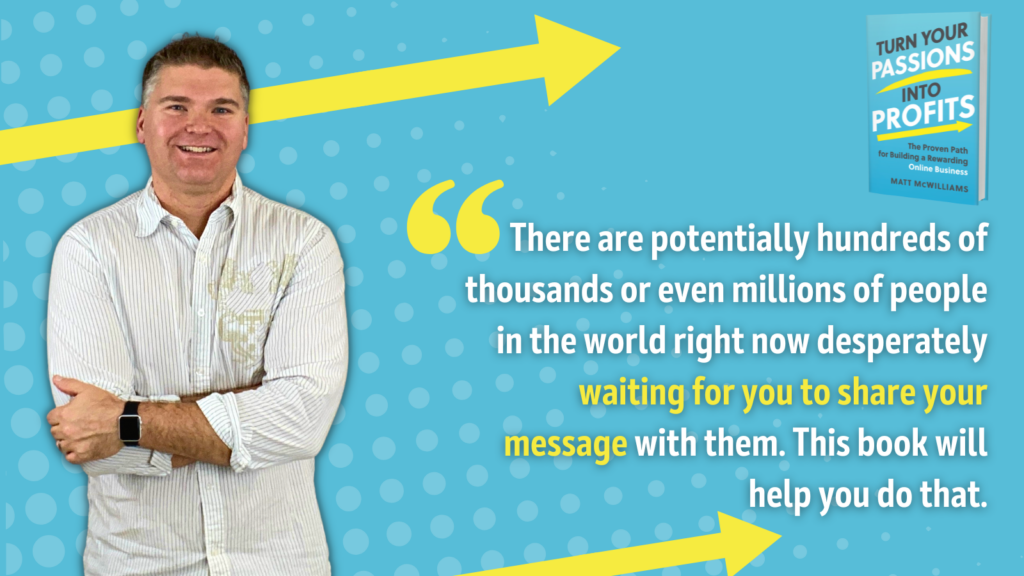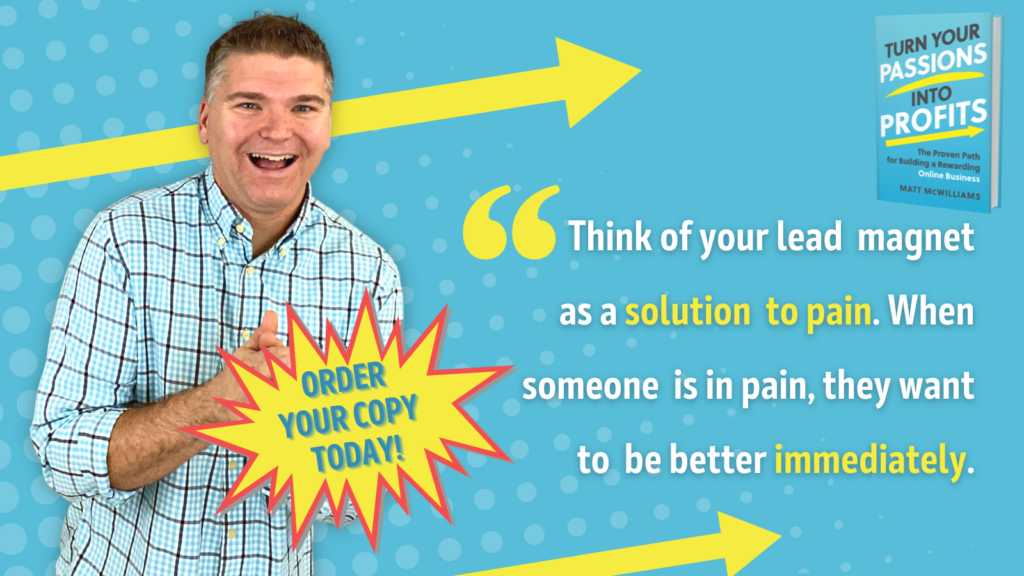We just hired our 15th team member. My role in our company is changing dramatically. But it hasn’t always been that way. It started with one part-time virtual assistant many years ago. Today, I’ll share the strategies we’ve used to build our team and show you how you can build yours, starting from your very first hire on up to building a full team.
Click Here for The Written Transcript of This Episode
NEW EPISODE: “Book Launch Party: An Interview with Matt About Turn Your Passions Into Profits” Listen here now!
Links Mentioned in this Episode
Don’t Miss An Episode – Subscribe Below
Previous Episodes of The Affiliate Guy
How to Work with An Affiliate Network: Q&A Lightning Round
Don’t Launch if You Don’t Want This…
The Worst Part of My Entire Business: Why You Need to Hire an Affiliate Manager
How to Decide to Accept or Decline an Affiliate
How to Write, Publish, and SELL Your Book with Chandler Bolt
How to Use Affiliate Marketing in a Book
How to Build Your Team: Working with Virtual Assistants, Contractors, and Full Time Employees to Scale Your Business
We just hired our 15th team member, and my role in our company is changing dramatically, but it hasn’t always been that way. It started with one part-time virtual assistant many years ago, and we built it from there. Now, today, I’m going to share the strategies that we’ve used to build our team and show you how you can build yours, starting from your very first hire on up to building a full team. So this is something I’ve been asked a lot about lately. We’ve hired a lot of people here in the past six, seven months. Gosh, just since September of last year, we’ve brought on 1,2,3,4,5,6 team members. This is not my first rodeo, so to speak. I’ll talk about that as we go. But I’ve been getting a lot of questions about that because people see that we’re hiring, we’re posting like we’re hiring, we’re hiring, we’re hiring. We keep emailing my list about hiring. And just as a side note, if you’re interested in working with us, please go to mattmcwilliams.com/careers. Please go there, because we’ve got many positions open that we are looking for. But a lot of people have been reaching out to me. And I got this particular email the other day that said, how in the world do you keep up with everything, keep track of everything, and keep it organized. Also, how can I best delegate some of my affiliate campaigns to someone on my team? It just always happens that I have multiple campaigns running very closely.
Here’s the thing. I run these mega launches, right? We’re running a dozen ten launches this year, plus some Evergreen programs. We’ve run programs for Michael Hyatt, Ray Edwards, and Lewis Howes. We’ve run these big book launches, these big product launches. We got Stu Mrclaren coming up for the membership experience. That’s going to be an eight-figure launch. We’ve got Ryan Levesque with Quiz Funnel Masterclass. That’s going to be absolutely huge. We coach people like Jeff Walker and all these people that we work with. And the thing is, most people have two to three launches a year maybe. My company will run ten or twelve plus evergreen, plus coaching. And I’m personally involved in all of them. On top of that, I release two huge pieces of content every week, this podcast. And we do a live lesson every week. And we have tons of other content that we’re in. We got videos, we got podcasts, we got blog posts. We got opt-ins that we’re creating products that we’re creating. We redo our courses every two years, like social media, all these things, conferences, meetings, the one-on-one coaching that I do, and consulting with companies. As I said, the course is like how do I get it all done? Well, the answer is I don’t, at least not myself. I delegate. I have built a team and so that question, how do I get it all done? Well, I don’t lead to some other questions I’ve been getting about hiring.
If you are ready to take your business to the next level and start an affiliate program, start with my free report, Your First 100 Affiliates. This report takes nearly two decades of experience, trial and error, and lessons learned about finding top affiliates in nearly every conceivable niche and puts them all into one report. Grab your copy here!
Today I want to share some lessons I’ve learned about building teams. This is the second company that I’ve run that is built at scale. It’s my fourth company overall. The first one, we ended up with three team members, and eventually, we got to like maybe two-thirds of a million dollars in revenue a year and made good money, and then it failed. In the second one, we built 52 team members. I’ll talk about that as we go. We’re doing over a million dollars a month just from our affiliate program. The third one, it’s like Bruno, we don’t talk about that one. If you’re listening to this in 2025, you’re like, I don’t get the reference. But if you’re listening to this in 2022 that we don’t talk about The fourth one here, we’re up to 15 team members. We’ve been at this for about nine years. It started with just me. And that’s something I want to talk about first. Do you start a loan or do you build a team? And I got this email recently about a brand new entrepreneur. Very common question. He’s in the early stages of building his business. And if you’re listening, you’re new, you’re an aspiring entrepreneur. You probably found yourself asking the same question or you’ll be asking yourself this question next week. He said I’m in this ocean of entrepreneurship dilemmas. I’m just starting my business. I’ve been told that I need to outsource certain things to offer a full range of services. Should I start out doing it all myself, contract out more complex projects or hire someone?
That’s a great question and I’m going to share with you a little bit of what I wrote to this person in response. I said, always start out doing it yourself. yourself as long as you don’t undercharge because you’re doing it yourself. So if you’re working with clients, as long as you don’t undercharge or overpromise, you’ll be fine. There are three huge benefits to starting it out by doing it yourself. Number one, you get to keep all the profits. When you’re first starting out, you need all the money you can get back to that first business. That very first business that I mentioned, I started in 2003. Soon after I started it, my dad fired me from my full-time job. I share the story often about how I got into internet marketing in golf instruction. I wasn’t an entrepreneur. That was not my business. I worked for my dad. Now we split the money on our golf schools if you’ve ever heard me tell that story.
But I was not an entrepreneur. I worked for him and he fired me. And I offered a very narrow range of web services. I had one client that was awesome. That client was paying me $500 a month, and I had plenty of savings from the I was making close to $200,000 a year running these golf schools. I made really good money because I got really good at marketing, but that was still nice to have $500 a month coming in because I was young. I was 22. I think, like 22 or 23 fire me in the dad for my birthday. I just turned 23, and I didn’t have a ton of expenses. I could live off of, like, $1200 a month. So having quite a bit of saving, plus making $500 a month, was nice. But overnight, I went from, like, a fun side project, making $500 a month for spending, like, 2 hours maintaining this website to this is now my sole source of income. I needed more money. I really wasn’t in the position, even though I had some savings to hire freelancers before I was actually paid by my clients. So I needed all the money I could bring in.
So initially, I learned how to do everything myself. I expanded my services. I picked up a bunch of new clients. I spent half my time learning how to do things that I said, yeah, we can do that. And then I’d spend the next two days learning how to do it. But I got to keep all the profits, and I built that emergency fund up. And in the process, I learned benefit number two, which is that you broaden your skillset, you learn new things that you like to do. The day after my dad fired me, I started reading everything I could about web design. I went from, I just kind of want to do this. It’s an easy web project. I know how to design websites, too. Oh, my gosh. I have to be, like, the best at this. And so I started selling my services to a broader range of customers.
Initially, all I did was basic design services for small businesses suddenly I was doing online fundraising for political campaigns and non-profits. I was building these elaborate, at least by 2003 standards, these elaborate e-commerce sites. And I was running these shiny new things called weblogs. People don’t realize the blog was short for weblog, by the way. Most people forget that. But I was doing blogs back in 2003. They were just called web blogs. And so typically, I would have these conversations with these prospective clients, and they’re like, hey, I’d like to do this. Can you do X, Y, and Z, right?’ And I’m like, of course, I can. And then I would be like, I’d write up a proposal, like, here, we’re going to charge $5,000 for that. And then I learned how to do X and Z. I didn’t know how to do X and Z. Each sales call, each new client, the amount of new stuff that I had to learn was astronomical but along the way it got lower and lower because I knew how to do stuff and then we got to the point where somebody would say, can you do these five things? And I’m like, oh my gosh I know how to do all five. Yes, I can do those in an afternoon and make four grand. So I was building my skill set up.
I was learning all kinds of new technologies and expanding the possibilities of what I could offer other clients. I even became an expert like accidentally in online fundraising. For most candidates political candidates since 2004, most nonprofits didn’t have an online presence. And if you remember back Howard Dean right with I cannot do an impersonation. I just sounded like one of those wind-up toys there. I cannot do an impersonation of that screech or whatever he did when he lost in Iowa but he was beginning to revolutionize. Give the guy credit whether you like him or not. That’s not the point. He was revolutionizing the internet and politics. He had a guy that ran his campaigns. I think his name was Joe Trippy and it was amazing what he was doing. This is only 18 years ago I had local congressional candidates raising tens of thousands of dollars per week online. This was an astronomical amount back then. Well, to them it was found money. Well, you can raise $100,000 in six months. Yeah, we’ll pay you 15%. I’m like, okay, all you got to do is raise money online and you’re going to give me money. I mean this is amazing. This was unbelievable. Nobody had platforms for collecting the money so we were using our own shopping cart and then having to dole it out to the campaigns charging them 15%. Now we had expenses. We had our two-point 99%. It was like $0.30 per transaction plus 2.9% so we weren’t making 15%. We were probably netting 10%.
So I remember, like, I had one guy, Congressman Howard Coble, and in the first year, we raised like $4000, for his pack. Well, 10%. I was just fiddle farting around on the Internet. I didn’t know. But I was learning these new skills that I loved using. I found that I loved writing. I enjoyed doing certain things that I just never even knew. And these discoveries became the basis for what I would choose to outsource and what I would choose to do myself. So as I built these skills and I grew my client roster significantly, I reached a point where I was simply unable to do everything myself. I was working 15, 16 hours a day, seven days a week. So then I began to outsource some things. And the cool thing about that was now I knew like, oh my gosh, before I just knew that I liked A and B. But I learned I also liked C and D, and I hated everything else. But now I got to do the four things that I loved. And maybe I thought I liked A and B, but I actually liked C and D more. I found that the writing side, I loved the process side that I loved, the planning side, the client communication side.
I loved talking to clients and hated designing the websites. And that leads to benefit number three when you’re first starting out. Why you should do it yourself is that you learn how to communicate with your team. Whether you outsource or you hire in-house, you have to be able to know how to communicate in the language of your team. And I don’t mean languages like when I speak Spanish or French. I’m talking about the languages of coding and design and marketing and the like. You do not need to become a marketing expert. You do not need to become a copywriting expert. But if you’re going to work with a team of copywriters, it might help if you go through a single copywriting course and maybe write a few emails of your own. When you start off outsourcing, start off hiring, you learn nothing new, and you find that you’re always going to have problems communicating with your programmers. Your marketing people use a bunch of fancy-sounding jargon to talk over your head and hide the truth from you, but not if you start off doing it yourself.
So because of that basic background that I had and think basic coding, design, marketing, honestly, still, am I’m able to effectively communicate with programmers, designers, marketers. I know when they’re talking out of both sides of their mouth. I know how to avoid bad hires, and I rarely have made bad hires in those areas thanks to this doing it all yourself. Just to be clear, it’s not a permanent solution, okay? If it stays that way for five years. You’re not an entrepreneur. You just own your job. You want to build a team. That’s what we’re talking about. You want to build a team, either in-house or virtually, or with contractors. Whatever you do, want to pay others to do the stuff that you can’t stand to do and focus on what you’re best at. But first, you need to keep the money for yourself, build that skill set, and learn the things that will serve you down the road.
Now, as you get ready to bring on team members, there’s something important you need to do. And we’ve talked about this before, and that is you need to know your Freedom Compass. And the Freedom Compass is something that Michael Hyatt teaches. And basically, these four zones, if you can imagine these lines, vertical line and a horizontal line of skill, proficiency, ability and passion, enjoyment, desire to do things. And there are these four zones. I’m going to talk about those real quicks. The top zone is the desired zone. The desire zone is things that you are both good at and you enjoy doing. So just imagine the lines intersect perfectly. Thereof passion and proficiency. The drudgery zone. Both of them are bad. You hate it, and you’re not even good at it. The distraction zone is things that you enjoy but you’re not good at. These are fun. They’re great distractions, but I suck at them compared to somebody who’s a professional. And then the disinterest on is the things where you’re actually pretty good at it.
These are things a lot of entrepreneurs find. Like, I’m the best person in my company at this, but you hate doing it. So for me, Desire is coaching, affiliate management, course creation, and teaching in the podcast. Those are my five things. That’s it. If it doesn’t fall into those, it’s not in my desire zone. The drudgery things that I’m terrible at and I’m not very good at financials, the tech work, anything involving spreadsheets, mundane tasks, HR stuff. Those are just distractions. These things I’m really good at or I really enjoy. But I’m not particularly good at, graphic design, video editing, those things. Like, I’m not really great at them, but man, they’re fun. Like the graphic design. I used to love doing graphic design because it was like an hour of just doing the graphics. Somebody else can do that in 15 minutes, even at $100 an hour, which is not what it costs. It’s going to cost me $25 to get that graphic done instead of me spending an hour. So the question is not, would I pay somebody $100 an hour to do graphics? It’s what I pay the math on that if I want to pay them $25 for 15 minutes, but it’s going to take me an hour. Yeah. Would I pay $100 per hour? Won’t know, but I already am, if you think about that. That’s the distraction zone stuff for me. The disinterest in the things that I’m good at, but I just hate doing editing the podcast. I’m good at it. I can get it done, but I hate doing it. Replying to most emails, scheduling things.
So you’ve got to know the freedom Compass, like, sit down, take the time, make a list of everything you do, and put them into those zones. Is this desire, Drudgery, distraction, or disinterest? This allows you to know what to hire first, so that’s step one. Step two is to hire a part-time VA for as many drudgery tasks as you can. 10 hours a week, 15 hours a week, 20 hours a week. I would focus immediately on getting rid of Drudgery tasks, the things that you suck at and hate doing. For me, that was part-time, about 20 hours a week. Virtual assistant, a VA to do all my spreadsheet work, do research, schedule social media posts, and format blog posts. I enjoy writing blog posts. I just don’t want to format them. I don’t want to have to spend the hour that it takes to make them look pretty. Transcripts, things like that. Step three is to scale up the virtual assistant. Scale up the VA to take on more and more tasks. So once you’ve eliminated Drudgery tasks, and this might mean adding a second VA, move on to the distraction and disinterest zones.
Personally, it took me a while. I needed one and a half VAs just to eliminate all my Drudgery tasks. And then I really wanted to focus more on eliminating tasks that I hated doing versus tasks that I enjoyed. But maybe I’m just not very good at, it because that’s just what I chose. There’s no perfect way to do this. You may eliminate disinterest and then distraction or distraction than disinterest or maybe things where you rate them. You say, Well, I really hate doing this, but I’m actually pretty good at it versus I only kind of hate it, and I’m pretty good at it. Get rid of the worst stuff first. So at this point in our business, I think I had two VAs. It was me, two VAs, and I still had most of the stuff I kept the graphic design, copywriting, video editing, all that stuff for years. And the simple reason is I enjoyed the work, and we weren’t ready to hire somebody for those roles. But about two years ago, we hired a graphic designer.
That was like the first distraction zone hire that we made. Now, to be clear, graphic design is not a typical VA task. I’m just using that as an example here. We did not assign that to a virtual assistant. We actually hired a graphic designer. But just keep offloading as much as you can from the Drudgery, the distraction, and the disinterest zones. And then, fourth, hire additional people as needed. Now, this is where you’re going to look for specific roles. Typically, these are contractors hired for a specific purpose. So these are things. Just some examples. Graphic design, copywriting, podcast editing. And this is actually Chris at Podsworth, not a team member. He does one thing the only thing he does on our team is podcast editing and I don’t consider him a team member. He’s an outsource person.
So copywriting, podcast editing, graphic design, advanced tech work, bookkeeper, video editing, and customer service like you can hire them part-time or full time just depending upon your needs and so you’re going to base those hires again. What are the parts of your business where you go that is drudgery, that is the distraction that is I’m just disinterested and you begin to outsource those, and then over time as you build your team you’re going to need additional specialized roles? You might need an operations manager for us if you’ve never read the book rocket fuel highly recommend every entrepreneur read the book rocket fuel. That book has just been transformative in our business because it showed me that there are two types of entrepreneurs. There’s the visionary and the integrator. The visionary is the idea minute guy that’s me.
All the ideas in the world are terrible at implementing and the integrator is the one who makes things happen. That’s our operations manager once you have three or more people on a team so hey, we got three salespeople we got three customer service people. They probably need a specific team leader that isn’t you. Now you might keep one team. That’s yours. I will probably always lead our team of affiliate managers I’m probably always going to be the team lead but I’m not going to lead our customer service team I’m not going to lead our finance team, I’m not going to lead our marketing team or our sales team or any of those teams like I’m going to lead our affiliate management team. That’s it.
You probably need a marketing manager over time, an affiliate manager. We talked about that before. Got an entire episode coming up about hiring an affiliate manager. You need salespeople and a sales manager, project manager, HR manager, CFO, and client success specialist. That’s when we and we just hired like those are all likely full-time positions. So over time, you’ve progressed, you’ve offloaded your drudgery Yay, you’re not doing things you hate and that you aren’t good at. Then you’ve offloaded the things that you hate but you’re good at and then the things that you really enjoy but you’re not very good at to be better as a company.
Now, eventually, you even start to offload some of your desired zone tasks for me, copywriting. I am good at it. I’m really good at it and I really enjoy it. But it’s a nine out of ten on both of those. It’s not a ten out of ten. And I had to make room for higher leverage tasks. And the reality is, for me in our company, if I can spend an hour writing copy or an hour leading our team, or an hour meeting with a client, those are higher leverage tasks than writing copy. So we hired a copywriter. Over the next year or so, I’m stepping down as CEO. This is a big decision and it’s something that one of the biggest roles of a CEO is company culture. I’m not great with that. And we need somebody who can come in and focus on that so that I can do what only I can do. Lead the affiliate management team, and be the face of the company. We’ve replaced probably 20, maybe upwards of 30% of my desired zone tasks over the past year or so. And so that’s eventually what you’ll get to you’re even replacing your desire zone. Some of those lower-level desires on tasks.
We basically took those desires zone tasks and anything that was like an eight out of ten on one of them, we removed. But then we looked at here are two desires on task and you can only do one of them. This one brings in $100,000, this one brings in $10,000. Well, I need to do the $100,000 thing. So that’s what that looks like. Now, in the hiring process, I get asked a lot about this. How do I actually hire people? It depends a little bit on the role. If we’re hiring a part-time ten hour a week type position and it’s an hourly rate, an hourly wage, and it’s a pretty simple thing that’s going to look a lot different than if I’m hiring like an operations manager if I’m hiring ahead of HR if I’m hiring a salesperson even so an example like if we’re hiring a part-time contractor who has a proven track record and I’m thinking of a person on our team, part-time contractor. She’s a referral from a friend. That was as simple as a single interview a single phone call, and then we had to do a test project, and I was like, yeah, you clearly got this. You’re good. You’re on the team. She had that proven track record. She had a referral from a friend. Yes. We wanted to do our due diligence. I wanted to make sure just because she can work with my friend doesn’t mean she can work with me, because maybe we don’t get along. Maybe I don’t communicate well. And I assigned her a test project. And part of that is to say, does she understand the way that I assign things? Does she understand my communication style? If not, then we have two choices. I can adapt, or maybe it’s just not going to work.
Ready to turn your passions into a profitable business? Check out my new book here!
There are a lot of people out there that want to work for us and are capable of working for us. So maybe I just need to find somebody who gets me better. And so it’s an opportunity for us to learn. That’s an extreme circumstance where the hiring process was two days long. Other times, I know the person’s work. Our graphic designer, Jim, is a great example. He was a student. He joined No Product No problem in 2017. He was in our Start Mastermind for two years. I had spent hundreds of hours with him. Effectively, it was an extensive job interview. I had seen his work. He actually had done some graphic work for other people in our mastermind, just as a kind of side project. So when we were looking for a graphic designer, I didn’t go to Google. I didn’t put it up on the website. Like, we never had graphic designers listed on our careers page at mattmcwilliams.com/careers We never had that. I just texted Jim and said, hey, do you have some time to talk this week? I’d like to talk to you about being our graphic designer. No interview, no test project. I just hired him because I knew so much. You spend 150 to 200 hours with somebody and you see three dozen samples of their work. You don’t need an interview. You don’t need them to do test projects.
Now, that’s usually fine for a few positions. There are probably people out there that you would be willing to just hire. I think of our podcast editor. He’s not a member of the team, per se. He’s just a contractor. It’s a company that actually does it. But I deal with one person there, and I was referred to him by somebody else, and I reached out and said, Are you looking for new clients? He said, yes. I said, Cool, you’re hired. Like, I know your work. I listen to this guy’s podcast. I know your work. So eventually, though, you’re going to have to hire people in other ways. I’m going to walk you through our process. It’s an eight-step process. It’s very extensive. I subscribe to the old philosophy in hiring, hire slow. I would rather put people through the wringer and have them come out going, yes, I still want to work with you, Matt. I know you’ve put me through all these test projects and you’ve done this stuff and I still want to work with you. And then they stay with us forever. That’s what we want. When I think of our hiring process, the goal is to identify the single best candidate. It really is. It’s to identify the single best candidate.
Typically, we start off we hire mostly from our audience. Outside of one person, I know two people. So outside of two people, everyone came from my audience. Of those two people, one was the one person I talked about earlier. They were a referral from a friend. And the second actually is a family member outside our audience per se but knows us pretty well. And so there are exceptions to that rule. But hiring inside my audience, especially with things like content creation, customer service, hosting, graphic design, like they know my brand, and that’s super important. So the first thing that we do is we reach out to our audience by sending an email and just putting it on our careers page at Mattmcwilliams.com/careers And you can see a lot of this stuff in action there. You can see how we do this. We get a lot of applications from this. So we create a very extensive application. I mean, I’m going to pull up two of ours for our agency. First name, last name, email, phone number.
Please describe why you want to join the Matt McWilliams Consulting Incorporated team. I’m not necessarily looking for the world’s perfect response there, but do you put more than just a sentence, do you think this through and tell me the reasons? I want to read through that. Do you have any previous experience as an affiliate manager? How many affiliate offers have you promoted? I don’t care if the answer shows are no or zero. In fact, I kind of like it when it’s no. I kind of prefer people who don’t have any experience because I can train them up in our ways. I do prefer it if you’ve promoted at least some affiliate offers. It’s not a requirement, but I prefer it. Please describe your current job or business. What do you like most about your job or business? What do you like least about your job or business? Like right there. What I’m looking for is please describe it. I’m a salesperson. Really? That’s the extent of it? No. Like, tell me about it. Can you communicate in written format? That’s an important job of an affiliate manager. What do you like most about it? I’m going to know. Are the things that you like most going to jive with our company? Well, I like most that it’s a very structured work environment with consistent hours.
Well, that’s not going to work for us. What do you like least about it? Are you a whiner or do you put an honest answer? Yes, you can be on your way through this but I still want to know it. And I still want to know. Do you communicate it? Do I come away clearly understanding what you like least about your job and what you like most? Please describe why you make a good affiliate manager. In other words, sell me on it. Can you sell something to me? I say the following are open-ended questions with no right or wrong answer. We are simply looking to learn how you process through certain situations. If you’re running an affiliate program and you find that one of your top affiliates is breaking the rules, what would you do first? How would you proceed from there? That’s an example, right? And I have a few of these. They’re sample things. Sample situations. What would you do? Here’s what I’m looking for. I’m not looking for the right answer. But what would you do? And I’ve had people put literally wrong answers but they explain why they would do it. I can teach them the right answer. These are all things I can teach them the right thing on. That’s not it. I just want to know how would you process it? How do you think through this situation? Can you communicate that? Then I have a section that says affiliate program questions. All of these answers can be found on Matt’s website or podcast. So three questions according to what is the ideal cookie link for affiliate programs.
According to Matt, what is one of the three C’s for a successful affiliate program? What is one of the reasons why affiliate programs should work with small affiliates? Here’s the thing we say right there. They can be found on the website. So there are only two ways to answer these questions. Number one, you got to be a big enough fan that you already know the answers or you got to go do the research. And here’s the deal. I had somebody I remember one application, we had like 52 applications and one of them put I couldn’t find this information. Really? Every single other person answered the question. You said you couldn’t find it. You’re not going to be a good member of our team. And so the question goes on. There are a few other questions on there and it goes through. The thing is that application, we’ll go over this in a second. With that application alone, we can weed out about half the people just based on that application. The other examples are content writer applications. We ask for all the basic stuff. First name, last name, city, state, phone number, all that. I want their website. Most content writers have a website of their own. What is it? Let me go look through it. Facebook profiling, Twitter profiling. I’m looking to see can they write social media posts that are coherent?
We ask for three writing samples and then we have two questions. So we’re reviewing these. And I’m immediately looking through these and going, okay, some of these are just not good. Let’s see, on this one, we had 53 responses. So one more than for the agency. Tell us about yourself, your writing background, your career goals, and your aspirations. 500 to 1000 words. So here’s the deal. A couple of things on this one I’m looking do they follow instructions? Is it between 501,000 words? Why is that important? Because there are times when we submit articles and they need to be between 501,000 words or 1500 to 2500 words, whatever. But can you follow the simple instructions? You have a 500-word range. That is 1000 is twice as long as 500. It can be anywhere in there. You write 998 words. You followed the instructions. The first thing we do is use word count. It’s 307 words. That’s not long enough. You did not follow the very simple instructions. Oh, it’s 1400 words. That’s too long. I just need you to follow basic instructions. Of those 53, I’d be willing to bet we weeded out five people just based on the length. But I’m also looking for again when I read this, do I get a sense of your writing background yourself? I understand you, your goals, your aspirations, things like that. I’m not looking for perfect punctuation, but man, do you at least have some basic grasp of the English language here? And then I write.
The last question is about Matt McWilliams consulting. We believe in having fun and communicating with a sense of humor and the space below. Tell us about a time you receive some bad news, but tell it using humor. I just need to know, can you write something that’s a little bit funny? Can you make me just go? I don’t need to crack up. I don’t need to fall over laughing. But can you make me go? That’s actually pretty funny. So provide questions that make it easy to weed them out. Details like 500 to 1000 words. We often put when we have a detail-oriented position, like a bookkeeper or a proofreader or an operations manager, we want somebody that is detailed. I put detail in there, like make sure you include a blue Buffalo in your cover letter. We had one guy who went so far, and he knows what we do. This is great. It would be on his cover letter. He just knew this would work with me. He designed a blue Buffalo logo and put it up at the top of the cover letter. And then at the PS, he said, in case you’re using command F to find this blue Buffalo, so he knew that we might go boom, open the cover letter. Command blue Buffalo. Okay, yeah, they’re in. And I think there was one application we did that 25 people. Two people didn’t put blue Buffalo immediately. They’re out. They’re done. But of course, using that humor goes a long way. So step one is just that extensive application. Step two would be to review the applications.
Again, we probably average 35 to 50 applications for positions. We can weed out about half right away. I would say for the agency, we were higher. We had some really good applicants. I want to say we wheeled it out about 15 to 17. Of the 52, we had about 35 people make it to the next step. The content writer was higher. I think we had 53, and we weeded out, like 34. On the front end, we only had like 19 or 20 make it to the second step. So we weed out people based on those requirements and just based on their writing samples and how they’re communicating. Because if you think about just those two positions, for example, written communication is kind of a key thing. Kind of a key thing. I’m looking for their ability to communicate a concept, an idea, or a message. So number two, review the applications and weed out people. Third, review their social media and other public information. So if we started with 50 people, we’re down to 25.
Typically, it’s step three, will we add another five? Because they post a lot of crap on social media? I’m not looking especially for some positions. Are they social media experts? What we’re actually looking for? And I don’t look at these. I’m not the one who does this, but we’re just looking for are the kind of crazy? We don’t want crazy. I don’t care what your politics are. I really don’t. But if every post you post is this President or that President is the devil and he or she is a N*** or a Communist and the country is going to h*** in a handbasket, I don’t need that on my team. I don’t really care what your politics are, but I don’t need crazy on my team. Do that privately, that’s fine. But don’t be posting it on your public social media stuff. If you think about that. If everything they’re posting is profanity, that doesn’t fit my brand, you’re not going to be a good fit on my team. I don’t care if you say a cuss word every now and again, that’s not it. But if you’re going on social media and every third word is profanity, you’re not going to fit in on my team. If you’re going on social media and you’re posting sexist, racist, or misogynistic things, you’re not going to fit in on my team. It’s just not going to work. So we review their social media. We kind of get through the crazy.
So now we’re down to like 20. The point is just to continue weeding down to rule out the people who can’t. They can’t write, they can’t follow instructions, and they’re a little bit nuts. So we’re down to step four, which is we do an asynchronous interview. Typically, it’s about ten questions that we asked them to submit video responses to. I tell them what we’ll do is we’ll give them the stuff on Wednesday, we’ll give them the questions on Wednesday, I’ll tell them on Monday that I’m going to give them to them on Wednesday. But when I give them the instructions on Wednesday, they have until like Tuesday at 10:00 A.M. To submit them. Here’s what I’m looking for. A couple of things here. Number one, I’m giving them just enough time that they can do it, but not enough time that they can really think through the process. So if I tell them on Monday or even maybe the week before, hey, you’re going to get instructions Wednesday afternoon, it’s due Thursday morning. It’s on them to Mark of the time. Okay, now I get it.
I had a couple of people over the years respond back and say, Man, I have my kid’s birthday Wednesday night. And one of our core values as a company is that we ruthlessly protect our downtime and that we prioritize life overwork. That is a priority for our company. It is a core value. Like one of our team members said in Slack this morning, I’m going to pull this up here. This made my day. Said, one of my favorite things about this company is how we live our values. How we live our values is so important to me and to our team that when I had people say, I’ve got my kid’s birthday party on Wednesday night, we’re not going to get in till late. I’ve got to be at my full-time job at nine the next morning. Is there any way that I can answer these questions early? It’s much better than can I answer them later and I let them I give them the questions Tuesday afternoon and I say, okay, great. They’re due Wednesday at 10:00 a.m. So I’m not looking to put them on the spot. But the thing is I want to give them enough time to do it but not so long that they can take forever to answer them and they can think through it and plan it too much. I give them it’s usually about 18 hours to get it done. I give them like 334 Wednesday and they’re due at ten the next morning. We then review those.
Step five is we review those and we usually can eliminate five to ten people and get down to about ten to twelve people left. So we’re now down. We’ll just call it ten people. We’re down to ten people. What we will do now is a test project, an actual project that we want to be done. So if it’s a content writer, we’ll do like five different projects. We’ll have two people kind of do each one of the five projects and we’ll say, hey, go do this. Here’s the thing. We pay them for it. So this particular project is going to take 6 hours in this position. It might be a salary position. Let’s just say it averages $30 per hour. We’re going to pay you $180 to do this and we give them a very short deadline. This is like we assign this on Monday. It is due Thursday. I want to see how you operate under pressure. You have 72 hours. Like when you’re with us full time, you might be doing this in 24 hours. You have 72 hours because I know you have another job and so we give them a test project and we pay them for it and it’s something like in the content writer position, it’s something that we will use as we say it in the explanation. We will use your content on my website so we’re paying you for it. Think of it as a freelance project but then we’re judging you and from there we’ll get it down to about five people now. Other positions like content writer’s easy. We’re paying you to do this project.
I give you a synopsis and I ask you to go write an article. Great. We can use that article. That’s understandable I’m going to pay $180 and that’s about what I’d pay a freelance writer. Maybe not quite as much, but roughly. And so we’re going to pay for that project. We’re going to use it. That’s easy to understand. What if it’s something like a project manager? What do you do? How do you do that and actually make use of it? The reality is you don’t. We have them do test projects and we compare the results. And the reality is if we have usually something like a project manager, we only have like five, or six people left. At this point, the reality is I’m going to waste $1,000. That’s just the reality. I’m going to waste $1,000. They’re usually just test projects. But I would actually say for something like that, I didn’t waste $1,000 because I can use one of them. Or there might even be elements from a bunch of them that we use for something we want to do. And so it’s not a waste of $1,000.
It’s just I could have gotten the same work done for $200 and instead I paid $1,000. But I’m not worried about that because I’d rather pay the $800 and weed out people. So if I started with ten on the test project, I’ll get it down to maybe as low as three, maybe as high as six. And we just keep doing that. At this point, we’re down to five or so. We will do a formal interview. This is a live interview, 90 minutes long. At this point, we haven’t talked to them at all, really, other than via email, we’ll do an interview and just see how are we getting along, and how are we communicating with each other? There are other ways to do this as well. If you have more people, maybe you do a 20 minutes phone call and just eliminate a few people that way. I’ve done that. When I get to that final step and I’m still at twelve people, I’ll do 15 minutes. I literally will block off 4 hours and just do all twelve in 4 hours and kind of make some notes like, okay, I don’t think this person is going to work yet. It may be down to nine, but I’ll just keep alternating. Do interviews, not necessarily alternate, but do interviews, do more test projects until I’m like certain of the person and part some people drop out.
The funny thing is, with paid projects, very few people drop out. We’re paying him a pretty fair wage if the position pays. Let me just do some quick math. If the position pays $8,000 a month, for example, it’s 160 hours. I believe that’s $50 an hour and the test project is going to take 5 hours. We’ll pay them $250 for the test project. So they’re getting a pretty fair wage. So most people are kind of like, cool, I’m going to do my best and they do their best on this. They do their best on it. And I do hear from people that sometimes the test projects take longer because they know their test projects. When I put you under the gun and need you to turn around a project that takes 6 hours and I need it in 24 hours, I don’t expect an A-plus effort. I expect an A-minus effort. You know, that’s the reality of something that’s a quick turnaround. They still put in an A-plus effort on the test project because they want to impress. So that’s what that process looks like. It’s not perfect. I’m not saying I’ve got it down Pat, but I do feel like we got a pretty good process. I had some pretty good results.
So as we wrap up, the final thing to consider is delegation. It doesn’t help to hire people and then not delegate to them. This is a lesson I learned the hard way. I used to micromanage the heck out of things. And then I heard a quote along the way that I need to lookup. I think it’s Douglas MacArthur. There’s some World War II general might have been Eisenhower said, don’t show people how to do things. Tell them what you want to be achieved and let them surprise you. And I might have butchered the quote just a little bit, but you tell them the result you want and you let them surprise you. And I had to get comfortable with not needing things to be perfect. I had to basically say, you know, what is good and I don’t have to be involved is a win. But here’s the thing. Oftentimes they’ll do it better than me anyway. Maybe they don’t even do it how I would have done it. If they get a better result. Maybe they get the same result, but they get it quicker. Maybe they get the same result, but they also get this other benefit over here. Maybe they do it differently and they do it 5% worse and I’m like, no big deal. Maybe they do it the wrong way and it cost us $1,000 and I had to just be okay with this allowing people to make mistakes.
There are no fatal mistakes that anybody in our company can make. Everything is backed up anyway. We’re all online and so I just had to be comfortable. You know what? I’m okay with $5,000 mistakes today. I’m okay with the $10,000 mistake. I’m not okay with like a $50,000 mistake and I’m not okay if you make the same $10,000 mistake three times. That’s absurd. Stop making the same mistake twice even. But you know what? If you screw something up, you make a decision and it was wrong and I delegated it to you and it cost us $3,000. Alright? I delegated 14 other things to you and they were right and they made us $200,000 and then the one mistake you made cost us $300,000. I’m $197,000 in the black, and I paid you 70, and I didn’t have to do anything. That’s a win. That’s a huge win. And the thing is, anybody passed the very beginning stage, you can afford to bring on somebody. You can afford 5 hours a week, 5 hours a week to a virtual assistant to take off your drudgery work. You don’t even have to work less. Maybe you’re putting in 45 hours a week and you take off 5 hours of drudgery. You might fill those 5 hours up, but you’re filling them with things that you enjoy and that you’re good at.
So for me, my rules are this. As far as delegation number one, I delegate everything in my Dresser’s zone. Nothing is left there. I have a very small roughly 30 minutes, a quarter of the dryer’s own work. That is one of those, like, only I can do it type things. It’s some of the stuff with our financials, and I hate doing it, and I have to do it once a year. I meet with our CPA. It’s torture, but it takes an hour, and I’m done. That’s about it. I have 3 hours a year. In my judgment, zone number two, I delegate everything that’s in my distraction zone. In my disinterest zone, that’s under a value of $10,000. Okay, that might be higher or lower for you. But for now, actually, everything in my distraction zone and my disinterest on have been delegated. But my rules over the years have evolved, and that’s it. I was like, okay if it’s bringing in under $10,000 and it’s in my distraction or disinterest, I need to get rid of it. And then over time, it was like, okay, anything under 20, anything under 30, anything under 50.
Eventually, it was basically everything in my distraction and disinterest. Third, my first reaction is always to delegate, not to do it myself. I might later decide to do it myself. But first, I always think to delegate. So immediately, okay, this needs to be done. My first thought is, who can do this? It is not, how can I do this? That’s the biggest mistake people make is how can I do this? So my first thought is, who can do this? And what do they need? And then if I go, you know what? Okay. Actually, come to think of it, I really do need to be the one to do this right now. Then I do it. My first thought is always to delegate. Fourth thing is, if it’s repetitive, I always delegate. I always delegate repetitive tasks because repetitive tasks can be taught. Let’s say you do something that is 30 minutes a week, and it’s going to be done for the next five years. That’s 26 hours a year. Next three years, we’ll just go with 75 hours roughly. If I have to spend an entire month doing that task, 30 minutes a week And I have to spend that whole 30 minutes documenting it. This is an extreme example. Usually, a 30 minutes a week task can be taught in 30 minutes. But hypothetically, I have to spend four weeks and people think, oh, gosh, I have to spend four weeks teaching this and then they’re going to ask a bunch of questions and it’s not worth it.
At the end of about five or six weeks, I no longer spend any time doing that 30 minutes task I’m done. I might take 30 minutes and document me doing it, and then I do it again the next week And I do it again the next week And I do it again the next week, and then I answer a few questions over the next month, spend maybe another 30 minutes. Over the month, I spent two and a half hours Versus 75 hours over the course of the next three years. So any repetitive tasks I delegate, and if I know for a fact that someone else can do it as well or 90% as well, I delegate. Very simple. So how do you delegate? This is a huge one. This is something I learned from I think I also learned from Michael Hyatt.
Number one is I have to look at what the level of delegation is. Level One, the lowest delegation is basically done what I say, how I say to do it, that kind of thing, right? So do as I say. Don’t really ask questions. You can ask questions, but don’t veer off the how I tell you to do it. So you do what I say, how I tell you to do it and you report back to me at every step. So if there are five steps, the end of step one, you tell me right now, that’s very rare. This probably accounts for maybe 5% of our delegation. Level Five, which is the highest I’m skipping. And this is like the basic delegation is here’s the mission. Go accomplish it. I don’t even need to know about it. I don’t even need to know when it’s completed. Just go do it. This is also very rare. This is maybe 10% now, the most common levels for us are two through four. Level two is basically I tell them how to do it, And I expect them to do it that way. In other words, do what I say, but they report to me when it’s finished. I don’t need to know every step of the way. Just report to me when you’re done and tell me that you’ve completed the project. That’s probably 10%. Level three is to tell me what you decide, And I’ll approve it. In other words, I’m going to delegate this to I want you to do the work, but I want to approve your decision.
Here’s how to do maybe parts of it. You decide on the rest, report the finished product to me. In other words, make decisions and tell me what you decide. I’ll sign off on the steps right now. This is about 50% of our delegation. It’s in this middle level here. And then level four is again between level three and level five, of course, is basically, tell me what you did, why you did it, and how you did it. It’s not that level five where it’s like, here’s what to do. Go do it. I don’t need to know anything. I still want to know what did you do and how did you do it? And I can kind of give you some feedback on it. This is probably 25%. So as time goes on, I trust people more and more as their level moves up. We have team members that they’re probably 80% level four and five others are maybe 70% levels one through three. Most are probably 50, 60%.
Level Three, a little bit of level four, a little bit of level two, very little level one or five right now. But other team members might be 30% level 540 percent level five. In fact, some team members are right around 50%, level five, and probably 95% level four and five. It’s very rare. It’s like if there’s something new, we might drop down to level three. For me, the best way to teach people stuff is just to record videos and provide written briefs. So I write like a little half-page, one-page document that’s got the gist of what they need to know. We create SOPs standard operating procedures, if possible, we explain it live so they can ask questions and we record it and they’ve got their questions answered. The big thing, especially early on when you’re working with just a virtual assistant. Explain the reason behind the task.
The biggest mistake I made before explaining the reason was just kind of like giving somebody a task saying, I need this report and I need it by 04:00 p.m. Today. Why? What is the mission of this spreadsheet? Just giving them a 32nd explanation of the reasoning behind it opens up new possibilities. And this applies to everyone on the team. Explain the problem, explain the reasoning, and explain the solution. What’s the problem? Why is this a problem? Like, what are we going to do to solve it? Not necessarily the actual solution, but what does the other side look like? The problem is when our customers log in to the system, they see this message, and that’s a problem because it’s conveying the wrong thing. So what we need to do is fix that for all the people who are logging in. And here’s the best way to do that, I believe or it might be just now. Please go fix that. But explaining that reasoning gives them some of that background. It also allows them maybe they’ll find a better way because they understand the reasoning, they understand what we were trying to accomplish. And they say, but if we did it this way, it would work better. Oh, my gosh. That’s right. I was going to say download this report and compare it to this report and we’ll find the differences and they go, no, there’s actually what we need exists in the system already. And I’m like, oh, I didn’t know that. They know a lot more than I do.
In my new book, Turn Your Passions Into Profits, I show you exactly what types of lead magnets actually convert and lead to explosive list growth. Grab your copy here!
So be willing to take the time to explain things Be willing to take 30 minutes to explain a ten-minute daily task Because again, you take 30 minutes to explain a ten-minute task. At the end of that first week of them taking over that task, you’re already 20 minutes ahead. You’re an hour ahead. After the end of next week, you’re 10 hours ahead. Eleven weeks later, end of the year, you’re 40, 50 hours ahead. So take the time to explain it. Document everything in SOPs we have a whole Asana project of nothing but SOP so anybody can access and go in like I want to learn, how do I do this in WordPress boom, I can do it. So there you have it. How to build your team. I hope that helps you as you get started building your team and scaling from there. If you have any questions along the way, feel free to reach out to me anytime. You can text me anytime at 260-217-4619, feel free to text me.
And if you have any questions about this or anything else and then make sure that you hit subscribe and come back next week, I’m going to share something that just happened. There was an affiliate program that made a fatal mistake. I think it’s going to really hurt their business. Unfortunately, I’m going to share what they should have done instead. So they really screwed up. There’s a big lesson that you can learn. I’m going to share that in the next episode. So make sure you hit subscribe if you know somebody who needs that. Oh, gosh, they’re running an affiliate program. They don’t want to make this mistake. Share that episode with them. Make sure you tell them about this episode. If they need to learn how to build their team, tell them about this episode. Don’t information hoard. Share the info. Spread the love with them. Tell them all about it, and I’ll see you next week. Thank you so much for listening Bye.
Questions?
Text me anytime at (260) 217-4619.
Or…check out some of my free reports to help you get on the right track:
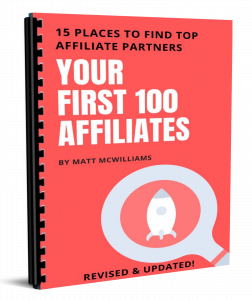 |
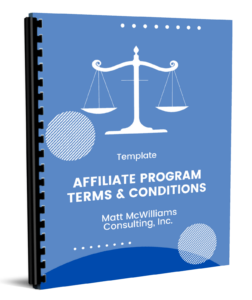 |
 |
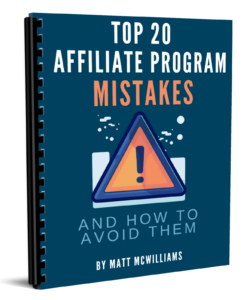 |
 |
 |
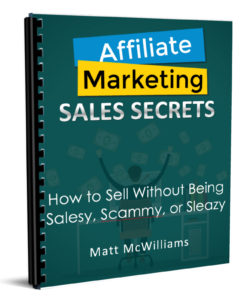 |
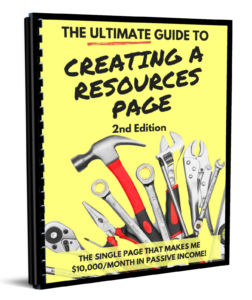 |
 |


